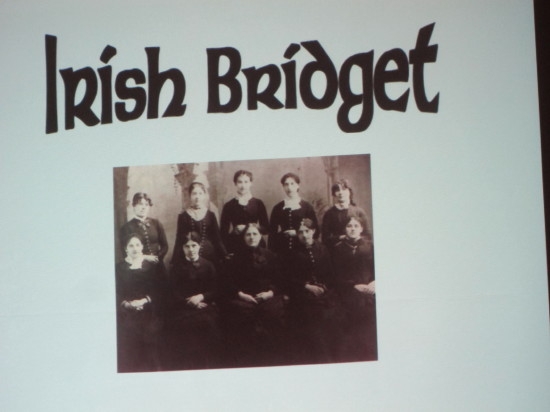
Courtesy of Rita King
Little is known of Catherine O’Connell beyond this surviving photograph. She appears long-suffering, keeping her own counsel, and perhaps far older than her years, for a good reason: The American version of Downton Abbey, at least in New Haven, was not all smiles, wit, and loyalty to the master, but grueling labor at often humiliating tasks.

Present-day New Haveners got a peek into the lives of Irish domestic servants like O’Connell in New Haven from the 1850s to the 1920s in a lecture entitled “Irish Women in Domestic Service.” The talk was part of the public programming for Beyond the New Township: Wooster Square, a quiet blockbuster of an exhibition at the New Haven Museum.
Because of “great attendance” and a desire to dovetail with Wooster Square’s Cherry Blossom Festival in April, the exhibition is being extended through May, said the museum’s Executive Director Margaret Anne Tockashrewsky.

More than 50 people, many with their own stories of a grandparent or great aunt who worked as a domestic, braved the icy weather to hear local historian and retired New Haven Register newspaperman Neil Hogan (pictured), now with the Connecticut Irish American Historical Society, share his research and photo archive at the lecture, this past Thursday night.
“Every Irish family [in Connecticut] has at least one [relative] who served as a domestic servant,” said Hogan.

“Irish Bridget” came to be a synonym for domestic servant, he added.
Because there’s a paucity of letters and diaries from these people in this era, throughout his talk Hogan solicited audience members to share their family histories with him.

As in this illustration from “Puck,” anti-Irish prejudice could take the form of portrayal as monkeys, and being inept.
Making more visible the “invisible communities” of historic Wooster Square has been one of the aims of the exhibition, said Tockashrewsky.
Long before Wooster Square became synonymous with the Italian-American historical experience in New Haven, the area was a mecca for impoverished Irish immigrants driven to New York, Boston, and New Haven in between, by what Hogan called “an gorta mor.”
That’s Gaelic for the “great hunger,” or the potato famines of 1845 through 1848.

Available census figures show that unlike other immigrant groups, Irish women numerically dominated the men. While the men went to work in the quarries, mines, and later the carpet factories, the Irish women went to work “almost universally,” Hogan said, as domestics.
Hogan was asked why, as the decades went on, they did not gravitate, as did the later Italian immigrants, towards the factory work in New Haven. “Good question,” he responded. He surmised that it was a question of poverty and that the women lacked other skills.
The domestics, meanwhile, worked as chambermaids, nurses, pastry chefs, seamstresses, laundresses, and other tasks. Some worked for short periods of time and then married. Others never married and attached to families they labored for.

That was the case with Catherine Foley. She’s the first cousin of Barbara Ortoleva’s mother. Ortoleva (pictured), who married into an Italian family that founded the New Haven Bread Company, said she knew little about Foley except that she was born in 1868 and died in 1968. She was a servant in the home of the English Family on Hillhouse Avenue.
Ortoleva, whose family artifacts are in the exhibition, said she was just beginning to do research on her relative.

That was music to Hogan’s ears. “We’ve only got tidbits of primary materials,” he said.